Rome in the Early Republic (509 - 241 BC)
Lapis Niger
Linked pages: Volcanal; Cult of Vulcan; Lapis Niger; Horatius Cocles


Rome in the Early Republic (509 - 241 BC)
Lapis Niger
Linked pages: Volcanal; Cult of Vulcan; Lapis Niger; Horatius Cocles
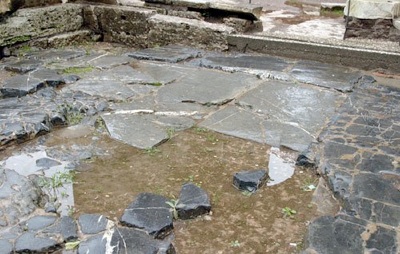
Lapis Niger, in front of the Curia Julia in the Forum, before it was damaged by heavy rain in 2008
From Christopher Lyes (referenced below, at p. 47, Plate 2)
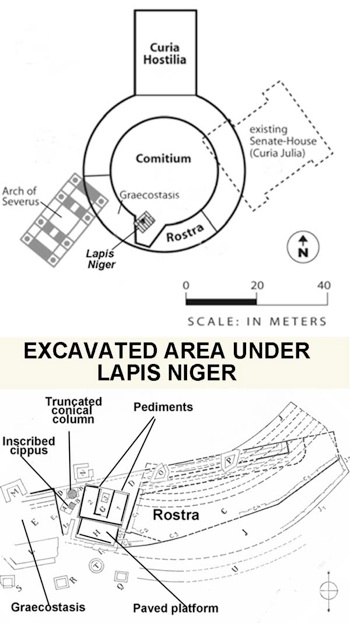
Above: Location of the lapis niger, adapted from P. Aicher (referenced below, at p. 87, Figure 21)
Below: Schematic of the excavated remains under the lapis niger, adapted from
Einar Gjerstad (referenced below, fig. 1), as reproduced by A. Bartles (referenced below, at p. 101, Figure 3)
In 1899, the archeologist Giacomo Boni discovered a black marble pavement of some 14 square meters in front of the Curia Julia: as Welbore St Clair Baddeley explained in the preface of his translation into English of Boni’s report of 1900 (referenced below, at p. 175):
“On January 11th last [1899], while workmen under the directions of Commendatore Boni were removing the rough post-Imperial ... paving-stones:
✴in front of [what was then] the church of Sant’ Adriano; and
✴some 15 yards immediately east of the Arch of Severus;
there came to light a pavement of black marble, rhomboidal-trapezoid in shape, and framed on three of its sides with blocks of travertine”.”
In this report, Boni (as translated by St Clair Baddeley) observed (at p. 176) that:
“Various hypotheses have been advanced in order to explain the meaning of this frame and fence; many the speculative arguments [have been made in relation to] the presence there of this marble and certain others, concerning which more presently. It ... seemed that anything might describe it [except] its very simple, correct name: Niger Lapis. As is now well known, Festus refers to it under this title in his treatise ‘De Verborum Significatione’: ...”
This is a reference to an entry by Festus (2nd century AD) in his epitome of the lexicon of the Augustan grammarian M. Verrius Flaccus:
“Niger lapis in Comitio locum funestum significat, ut ali, Romuli morti destinatum, sed non usu ob in...”, (‘De verborum significatione’, 184 L, lines 188-9)
Timothy Cornell (referenced below, at p. 419, note 42) translated these lines as follows:
“[The black stone in the Comitium] indicates a deathly place, intended for the death of Romulus.”
Jesse Benedict Carter (referenced below, at p. 26) observed that, while the rest of this entry, as it survives, is lacunose, lines 191-2 begin (respectively) with the fragments ‘stulum’ and ‘tilium’, which have been reasonably restored as Faustulum and Hostilium, indicating (respectively):
✴the herdsman Faustulus, who had rescued the abandoned Romulus and Remus and raised them as his own; and
✴Hostus Hostilius, the grandfather of Tullus Hostilius, traditionally the third king of Rome.
From this, Boni (as translated by Baddeley, referenced below, at pp. 176-7) argued that, by the time of Verrius Flaccus:
“The black stone in the Comitium ... was held to mark the sepulchre of either Romulus, Faustulus, or Hostilius, grandfather of Tullius.: [in any case], whatever it was, it was considered to be a locus religiosus et funestus.”
Excavations of 1899-1900
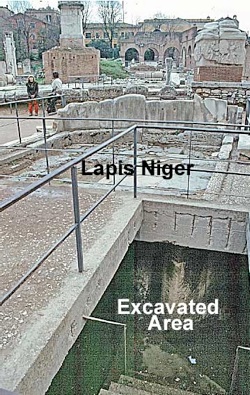
Site during the recent excavations under the Lapis Niger
From Christopher Lye, (referenced below, at p. 46, Plate 1)
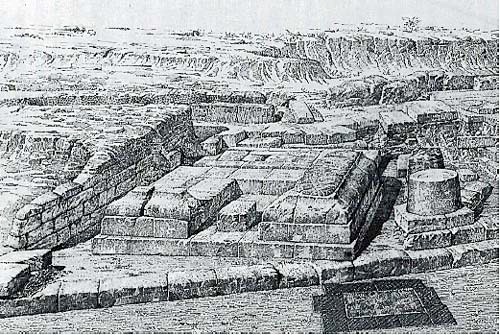
Monuments below the Lapis Niger, drawn at the time of excavation
From Stephan Smith (referenced below, at p. 328)

Model of part of the excavated site under the pavement (Museo Nazionale Romano, Baths of Diocletian)
Adapted from a photograph in this site by René Seindal
Christopher Lyes (referenced below, at pp. 45-6) observed that Boni’s excavations had unearthed:
“... substantial votive deposits (mostly from the 6th/ 5th and the 3rd/ 2nd centuries BC), and a collection of worked stone objects, [including]:
✴an inscribed cippus ... dated to the [early] 6th century BC;
✴a ... [truncated] conical column, 0.48 metres high, of Monteverde tufo, [which Samuel Platner, ‘Sepulcrum Romuli’, referenced below, at p. 483, dated to the 5th century BC] ... ; and
✴a discrete structure of the 4th century BC ... consisting of a rectangular ... foundation of worked tufo on which were two bases supporting moulded pedestals ... ”
Inscribed Cippus (early 6th century BC)
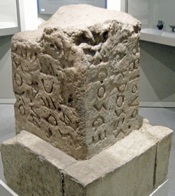
Model in the Museo Nazionale Romano, Baths of Diocletian
of the inscribed cippus that was discovered under the Lapis Niger
From this site by René Seindal
Giacomo Boni (as translated by Welbore St Clair Baddeley, referenced below, at p. 178) recorded that:
“Behind the [truncated] cone ... was found a broken stela of tufo, resembling the base of a small obelisk and having bevelled angles (a characteristic, be it remarked, of the plinth of the pedestals). It is fractured at 0. 455 m. and 0.610 m. of its height, non-inclusive of the small portion sunken in the grooved base upon which it [originally] stood, and now partly stands (for it was found to be slightly wrenched askew from its base frame). On the four sides and on the bevelled edge of the south-west angle ... is inscribed the writing [see below] ... that has already given rise to volumes of speculative argument ... ”
John North Hopkins (referenced below, 2016, at p. 51) observd that:
“Some time after ca. 560 BC, ... the Romans laid a new pavement in gravel at the Comitium and on it they placed [the] stone base for the new cippus [i.e. Boni’s inscribed stela].”
Christopher Lyes (referenced below, at pp. 45-6) observed that its archaic Latin inscription (CIL VI 36840):
“... has been described as Rome’s oldest [surviving] public document.”
John North Hopkins (referenced below, 2012) pointed out that:
“With a new paving of the Comitium during the late 6th or early 5th centuries BC, the Romans constructed two stepped platforms on either side of the cippus.”
In other words, the cippus and the area around it seems to have been respected in the development of the Comitium in ca. 500 BC.
The inscription uses an archaic Latin alphabet, and its 16 line were read from the bottom to the top and then back to the bottom of the cippus. Gary Forsythe (referenced below, at pp. 73-4) observed that:
“Although the precise meaning of the document is uncertain, [not least because the upper part of it is missing], four words are beyond dispute:
✴ [in line 2], sakros (= classical Latin sacer, masculine nominative singular), meaning sacred or, more likely, accursed, thus alluding to the imposition of a religious sanction upon an offender of this law;
✴[in line 5], recei (= classical Latin regi, indirect object in the dative case of rex) ... thus referring to either the Roman king or the rex sacrorum of the fledgling Republic;
✴[in lines 8-9], kala- torem (= classical Latin calatorem, direct object in the accusative case), meaning herald or crier ... ; and
✴[in lines 10-11], ioux- menta (= classical Latin iumenta, nominative or accusative neuter plural), meaning beasts of burden and hence also wagons, carriages or vehicles.
Since [the] cippus ... was not taken down and solemnly buried until imperial times (sic), it must have stood near the rostra throughout the Republic and was therefore on permanent display for inspection by anyone interested in it.”
Column (5th century BC)
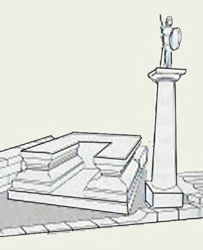
Hypothetical reconstruction by F. Coarelli
(referenced below, 1983, at p. 175, Fig. 47)
Giacomo Boni (as translated by Welbore St Clair Baddeley, referenced below, at p. 178) recorded that:
“Just beyond the westernmost pedestal, the layer of tufo-giallo turns a little southwards and supports a plinth, which is slightly curvilinear, carrying a truncated cone (monolith of tufo-giallo) ...”
Filippo Coarelli (referenced below, 2014, at p. 55) suggested that Boni’s ‘cone’ was:
“... the truncated shaft of a column (possibly the base for a statue).”
Bases Supporting Moulded Pedestals (4th century BC)
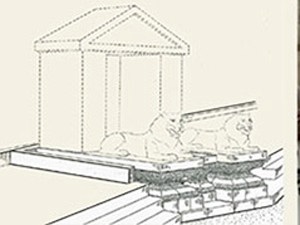
Hypothetical recreation by E. Gjerstad (referenced below, 136, fig. 8)
of the structure built on the excavated rectangular tufo foundations
From A. Bartles (referenced below, at p. 102, Figure 4)
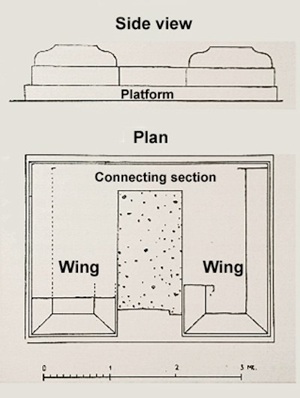
Side view and plan of the altar or base
From Stephan Smith, (referenced below, at p. 328)
As we shall see, a late commentary on a verse by Horace recorded that:
“Most people say that Romulus was buried at the rostra and that, in remembrance of this, there were two lions [there], just like the ones that we still see on the tombs ... Varro states that Romulus had been buried in front of the rostra.”
Giacomo Boni (as translated by Welbore St Clair Baddeley, referenced below, at p. 178), who apparently believed that Varro had been the source for all of this information, recorded that:
“In March [1899], the easternmost of the pedestals of [Varro’s] lions was found, and a little later the second was discovered, only a few feet west of it and within the same frame-base of tufo, practically situated beneath the ‘Niger Lapis’ [pavement].”
Stephen Smith (referenced below, at p. 327) observed that what he described as a base or altar was:
“First identified ... as the grave of Romulus, with the surviving wings as bases for lion statues. This was the accepted view until after the excavations at Lavinium, when[Ferdinando Castignoli, referenced below] argued that it was an altar with a similar design.”
However, he argued (at p. 328) that:
“Its shape is unique[among the known U-shaped altars of Latium in the period from the 6th to the late 1st century BC - see his pp. 284-295]:
✴it has squarer dimensions than any other U-shaped altar, with a much deeper space between the wings;
✴[there is] no trace of an offering-table between the wings;
✴[there is only] a very thin rear connecting section; and
✴its orientation is very different from all other U-shaped altars, which faced east.
There are contemporary foundations behind the connecting section that [have been] interpreted ... as supporting a sacellum dedicated to Romulus. These foundations and the block between the wings (H: 0.29m, L: 0.725m, W: 0.52m) are usually omitted in reconstructions showing the monument as an altar, since anything on the foundations would have been directly in front of the sacrificer (although the block may have been similar to the step on some of the Lavinium altars, allowing the sacrificer to reach the upper surface comfortably). The differences from other U-shaped altars are so pronounced that the monument is more likely to have been a base of some sort.”
As we saw above, Giacomo Boni (as translated by Welbore St Clair Baddeley, referenced below, at p. 177) assumed that what he called the pedestals (i.e., the wings of Stephen Smith’s ‘altar or base’) had each supported a lion and that , at least by the time of Varro (1st century BC), they were presumed to have belonged to a funerary monument. In fact, the link between Varro and the two lions is quite tenuous. It starts with a prophecy by the poet Horace (30 BC) that:
“A barbaric conqueror will tread on [Rome’s] ashes... [and], in his arrogance, will scatter the ossa Quirini (bones of Quirinus, the deified Romulus) that are now sheltered from wind and sun”, (‘Epodes’, 16: 10-14, translated by Niall Rudd, referenced below, at p. 307).
Horace might well have imagined that the ossa Quirini were ‘now sheltered‘ by the lapis niger. Varro’s association with this passage arises by two much later commentaries of this verse:
✴Porphyry (3rd century AD) observed that Horace’s prophecy had been formulated:
“... as if Romulus [had been buried rather than taken up to] Heaven ... In fact Varro [also] states that Romulus had been buried post rostra (behind the rostra)”, (translated by Diana Guarisco, referenced below, at p. 14).
✴Another (probably later) commentary known as the Pseudo Acronian scholia (already mentioned above) recorded that:
“Most people say that Romulus was buried in rostris (at the rostra) and that, in remembrance of this, there were two lions [there], just like the ones that we still see on the tombs (which is why dead men are [still] praised pro rostra (in front of the rostra)). ... In fact Varro states that Romulus had been buried pro rostra”, (translated by Diana Guarisco, referenced below, at p. 14).
In fact, all we can take from this is that:
✴Varro seems to have believed that Romulus had been buried somewhere near the Republican rostra; and
✴there was a tradition that two lions had graced his funerary monument there.
Interestingly, Dionysius’ of Halicarnassus, who arrived in Rome in 30 BC, recorded that:
“Some say ... that the stone lion that used to stand in the principal part of the forum, near the rostra, was placed over the body of Faustulus, who had been buried by those who found him in the place where he fell”, (‘Roman Antiquities’, 1: 87: 2).
If Stephen Smith (above) is correct that the pedestals were bases of some sort rather than part of an altar, then they could originally supported a pair of lions and formed part of what, at least by the 1st century BC, was though to have been a funerary monument (variously assigned to Romulus, Faustulus or Hostus Hostilius).
That leaves open the question of the original function had been. Stephen Smith (referenced below, at p. 76) accepted the suggestion of Filippo Coarelli (referenced below, 1983, at p. 133) that the base/altar probably dates to the second half of the 4th century BC. Smith argued (at p. 77) that this:
“... was a time when Rome’s Latin identity but pre-eminent regional status were being expressed through new foundation myths and shared religious festivals, [particularly] following Rome’s defeat of the rebellious Latin communities in 338 BC. This monument stood next to the [Republican rostra, which was named for the bronze rams that had been] taken from warships surrendered by Antium at the end of that conflict and attached as a trophy to the speakers’ platform in the Comitium. It would, therefore, have been an appropriate time and context for a monument to be erected commemorating some aspect of Rome’s origins, using an architectural design that had become associated with a traditional Latin identity.”
However, as we shall see, a number of scholars believe that they more probably belonged to an altar in the archaic shrine toVulcan known as the Volcanal.
Sacrificial Layer
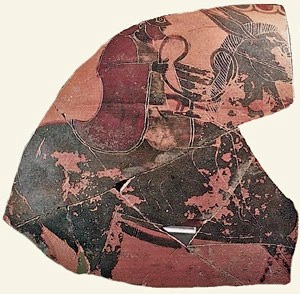
Fragment of a Greek black-figure krater (ca. 575 BC) from the Lapis Niger
(now in the Antiquarium del Foro , Rome)
The fragment depicts Hephaestus on a donkey, returning to Mount Olympus from exile
Adapted from Francesco Marcattili (referenced below, at p. 27, Fig. 8)
Christopher Lyes (referenced below, at p. 49) similarly that, before they were destroyed and covered by the black marble pavement, the column and the pedestals had stood on an ancient platform:
“... which [Timothy Gantz, referenced below] believed to be the old Republican rostra, and which [Einar Gjerstad, referenced below] identified as being of a yellowish‐brown tufo (Tufo Lionato), consistent with early works on the Capitoline [that dated to the earliest days of the Republic]. The careful arrangement and apparent respect for these archaic monuments suggests that their curation and commemoration had in itself significant antiquity. And this veneration of the monuments throughout the history of the site is reflected in Gjerstad’s interpretation, in which he has argued (at p. 123) for six phases of development:
✴In his earliest phase, he saw the cippus representing the most ancient [phase], initially standing as an isolated monument but subsequently incorporated into the first phase of the rostra as an object of respect; ...
✴in subsequent phases, the cippus was joined by [the column and] the u‐shaped altar [sic], which he envisaged as an aedicular shrine; and
✴the final phase was the partial demolition of the complex and its sealing off with the Lapis Niger pavement ...”
Giacomo Boni (as translated by Welbore St Clair Baddeley, referenced below, at pp. 178-9) described the aspects of this final phase that became evident during the excavation:
“The fracture of the [cippus, the truncation of the column] and the maltreatment [that is] evidenced by the condition of the pedestals [appears to] have been due to destructive operations of a very deliberate character. Abundant proof that this sacrilege was expiated by a national sacrifice [is found] in the layer lying above the ... uppermost gravel layer, which enveloped the pedestals, cone, and [cippus]. This may be called the ‘sacrificial’ layer. This layer, which is 0.40 m. thick on an average, is composed of ashes, charcoal and humus, and is limited by a Republican wall just beyond the easternmost of the pedestals, and again at the southern edge of the platform of tufo. It bears witness to the scrupulous care with which the expiation must have been carried out. In that sacrifice were offered numbers of sheep and goats, wild boars and some young bulls; and into its purifying flames were thrown hundreds of terracotta vases, bronzes, weights, astragals, dice, and other votive offerings.”
Christopher Lye (referenced below, at p. 49) considered the likely timing of this final phase. He observed that:
“... the orientation of the Lapis Niger pavement respects the [nearby] Curia Julia ... This suggests that its alignment was fixed when the Curia was rebuilt, in more or less its current form, after the fire of 52 BC ...”
According to Cassius Dio, in 44 BC, the Senate charged Julius Caesar with:
“... constructing a new senate-house, since that of Hostilius, although repaired [after the fire], had been demolished ... [so] that:
✴the name of Sulla should not be preserved on it; and
✴... [a] newly constructed [senate house] might be named the Julian, even as they had called the month in which he was born July ...”, (‘Roman History’, 44: 5: 1-2).
It seems that the work had not started by the time of Caesar’s murder, since, in late 43 BC, the newly-formed triumvirate of Octavian, Mark Antony and Lepidus:
“... built the Curia Julia, named after [Julius Caesar], beside the place called the Comitium, as had been voted”, (‘Roman History’, 47: 19: 1).
Finally, after Octavian’s triple triumph of 29 BC (on August 13th-15th, by which time he had gained control over the whole Roman state), he dedicated:
“... the Curia Julia, which had been built in honour of his father”, (‘Roman History’, 51: 22: 1).
Thus, it seems that the Lapis Niger pavement was laid at some time shortly after 43 BC, when the long-delayed building of the Curia Julia began in earnest.
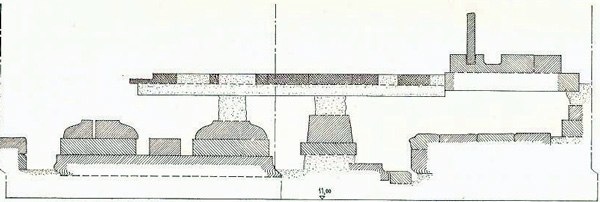
Side view and plan of the altar or base and the column after the clearance of the Comitum
From Aaron Bartels (referenced below, at p. 106, Figure 8)
Aaron Bartels (referenced below, at pp. 43-4) who drew directly on Giacomo Boni’s report of 1899 (referenced below) observed that the clearing of the site for the Lapis Niger in ca. 40 BC involved a process of demolition that:
“... left the plinths standing at under a meter in total height). [The masons] also evenly chopped the upper sections of the inscribed [cippus and the column] to roughly the same height as [the pedestals]. ... [This] was followed by a massive sacrifice. A terracotta bas-relief of a cavalryman with a spear, sat at the bottom of this burnt sacrifice layer, either having drifted down or [having been] placed [there] before the sacrifice. Either way the object was a votive, taken from a temple, an altar or a personal collection. With some of [the pedestal monument] still protruding, burnt soil, bones and artifacts built up on the reused yellow gravel, fully covering [the pedestals themselves] by 30 cm. Boni reports that bones of several tens of young bulls, sheep, wild boars and goats were found in the burnt layer directly on top of [them].”
The terracotta relief at the bottom of the sacrificial layer merits further discussion. This is probably the artefact that is described in Boni’s report (as translated by Welbore St Clair Baddeley, referenced below, at p. 180): a long list of items recovered from the ashes included:”
“Fragments of a Greek vase (Chalcidic) [dated] to ca. 600 BC. The exterior shows black figures on a red ground. Subjects: Bacchus (?) on mule-back, wearing a white chiton and purple hymation, and having a cantharos in right hand; in left, a bridle. Other fragments of the same vase display figures in motion: Manes (P), bridle of a quadriga, etc. This vase must have been 50 cm in diameter. It probably served as a water jug.”
This is presumably the fragment illustrated above, which Filippo Coarelli (referenced below, at p. 177) described as a fragment from:
“... a large Attic black-figure krater that, in terms of its size and quality, is totally exceptional in Rome. This fact, together with its dating to 570-560 BC, suggests that it may be una offerta di fondazione, [which I take to mean an object that had been offered at the time of the foundation of the putative shrine here and used again in the sacrifice that attended its destruction]. In this context, it seems to me to be of not unimportant that the subject represented on the krater [is] the return of Hephaestus [Roman Vulcan] to Mount Olympus”, (my translation).
IN CONSTRUCTION
Filippo Coarelli (see, for example, his book of 2014, referenced below, at pp. 56-7) located the Volcanal at location 4 in the plan above, within the area of both the archaic and the Republican Comitium, in an area that was later covered by a platform known as the lapis niger. This is based on the excavations that followed the discovery in 1899 of the lapis niger itself and an archaic hypogeum beneath it. Coarelli cited (inter alia) the evidence of a fragment of an attic krater (mid 6th century BC) that depicts Hephaestus (illustrated in Beard et al., referenced below, at p. 22), which was the most ancient of a number of votive objects that were found in the hypogeum.
This hypothesis has been widely but not universally accepted: for example, as John North Hopkins (referenced below, at p. 51) observed, this krater was:
“... part of a much later (1st century BC) ceremonial deposit, and therefore cannot be conclusively connected to the [hypogeum] ... in the 6th century BC.”
It is also important to note that none of our surviving sources explicitly locates the Volcanal in the Comitium and, as we have seen, an anecdote transmitted (via M. Verrius Flaccus) by Aulus Gellius specifically indicates that the statue of Horatius Cocles was moved from the Comitium to more elevated position in area Volcani. Furthermore, two of the other sources discussed above specifically located the shrine ‘above the Comitium’:
✴the pre-Julian calendar fasti Antiates Maiores recorded that the festival of the Volcanalia was celebrated on 23rd August supra Comitium; and
✴Festus/ Verrius Flacccus recorded that the grave and statue of a ludius (possibly a chariot driver) was removed from the Janiculum and relocated:
“... in Volcanali quod est supra Comitium ... ”, (‘De verborum significatione’, 370 L).
Filippo Coarelli (referenced below, at p. 177) argued that:
“If there is a connection between [the iconograhy of the black-figure krater and] the divinity venerated at the sanctuary, which I think is probable, then we have:
✴not only further proof [i.e., in addition to the indications that Coarelli had already extracted from literary and epigraphic sources] of the identification of the sanctuary with the Volcanal [archaic shrine of Vulcan]; but also
✴an interpretatio graeca (Greek interpretation) of [the Roman] Vulcan in the first half of the 6th century BC”, (my translation).
Some scholars have taken the discovery of this fragment in the ‘sacrificial’ layer as proof that the archaic Volcalal lay below the lapis niger: for example, Timothy Cornell (referenced below, 1995, at pp. 162-3) asserted that:
“... Filippo Coarelli has convincingly identified [the sanctuary that has been excavated under the lapis niger] as the shrine of Vulcan (Volcanal) referred to in the written sources. A votive deposit associated with the earliest phases of the sanctuary was found to contain a fragment of an Attic black-figure cup showing Hephaestus returning to Mount Olympus on a donkey, a well-known Greek myth. The presence of this scene in this context cannot be a coincidence. It confirms the identification of the [sanctuaryas the] Volcanal, and proves that, by [580 - 570 BC, in his view the likely date of the krater], the Romans already equated Vulcan with Hephaestus.”
However, this over-states the case, since, assuming that this terracotta fragment was the one that Boni discovered in the ‘sacrificial layer’ that covered the sanctuary when it was sealed in the 1st century BC, then it was not necessarily ‘associated with ‘the earliest phases of the sanctuary’: the vase certainly dates to about the time of the lowermost pavement of the sanctuary, but there is no hard evidence that this was its original location. Furthermore, it could have been part of a Greek krater that had been imported byan Etruscan: as Nancy Thomson de Grummond (referenced below, at p. 134) pointed out:
✴an Etruscan god called Sethlans seems to have replaced Hephaestus in depictions of this myth on Etruscan mirrors; and
✴imported Greek vases displaying the original myth were very popular in Etruria from the 6th century BC.
In a similar vein, Francesco Marcattili (referenced below, at p. 16) argued that:
“At the Comitium, fire must have been the pre-eminent element associated with the return from war, in a ritual that provided for the offering and burning of enemy weapons. [Giacomo Boni found] weapons [that he described as] ‘heavily oxidised’ during his excavation at the [‘sacrificial layer’] of the Lapis Niger, where the famous fragments of an Attic black-figure crater with the return of Hephaestus to Olympus, demonstrate the perfect (and early) theological overlap between Greek Hephaestus and Roman Volcanus, and ... the links between [Vulcan on the one hand] and the triumph of Romulus and the quasi-divination (eroizzazione) of victorious commanders [on the other]”, (my translation).
Marcattili followed Filippo Coarelli (as above) in relying on Giacomo Boni (referenced below, 1899, at p. 157, a paper that I have not been able to consult directly), who recorded the presence of the oxidised remain of spears or lances: these were presumably the ‘spear points, almost consumed by rust’ that are mentioned in the English translation of his paper of 1900 (referenced below). It is possible that these had been burned, but it is clear that they were relatively unimportant in relation to the other remains: Aaron Bartels (referenced below, at p. 48), who inspected all of Boni’s reports, was under the impression that:
“... Boni found no weapons in the burnt deposits [in the ‘sacrificial layer] ...”
Excavations of 1898-1900
Excavations of 2019-20
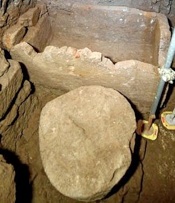
Sarcophagus and putative altar excavated under the steps of the Curia Julia
Photo by FILIPPO MONTEFORTE/AFP via Getty Images, from the website of ‘Vintage News’
Very recently, Alfonsina Russo (referenced below) reported the discovery of:
“... a hypogeum or underground temple and tomb structure with a tufa sarcophagus linked with what looks like an altar ... in the Roman Forum ... “
She observed that the excavated space:
“... is believed to be part of a votive area called a heroon [that was] devoted to ... Romulus. The sarcophagus, [which is] made out of the same tufa rock [used for the construction of the first buildings on the Capitol], is around 1.40 metres long and is believed to date back to the 6th century BC. The find was made next to the Curia-Comitium complex, a few metres away from the famed lapis niger, which Romans thought had brought bad luck because it was linked to the death of Romulus. The hypogeum is located below the entrance stairway to the Curia [Julia] ...”
As fas as I am aware, the details of these new excavations and their consequences for the interpretation of the site have yet to be published. It seems to me that the sarcophagus and altar might well have been moved here shortly before the dedication of the Curia Julia in 29 BC. They might well have belonged originally to the complex excavated in 1899-1900, where they would have added weight to the tradition that the cult site under the lapis niger had been a place of death.
In a recent edition of his work on this subject that has been published in English, Filippo Coarelli (referenced below, 2014, at p. 56) asserted that this group of monuments:
“... constituted the [original] Volcanal, the very ancient sanctuary of Vulcan, which various witnesses situate in the Comitium, near the Graecostasis and the Rostra. ... As Festus [quoted above], the only [surviving source for the] term lapis niger confirms, [this] was not the site of the tomb of Romulus, ... but the [traditional] site of his death ...”
He noted that Plutarch recorded that some sources that doubted the Romulus had been taken up into Heaven:
“... conjectured that the senators, convened in the temple of Ἡφαίστου (Hephaestus, Roman Vulcan), fell upon and killed him and cut his body in pieces, after which each hid a portion [of the body] in the folds of his robe and so carried it away”, (‘Life of Romulus’, 27: 5).
Finally, he suggested that the cult site survived the partial destruction of these monuments after 44 BC, and that it might well have been moved to the nearby site between the Curia Julia and the arch of Septimius Severus: a slab that was found here in 1548 bore an inscribed dedication (CIL VI 0457) by Augustus to Vulcan, dated to 9 BC.
Other Statues in the Volcanal
The shrine must have had a cult statue of Vulcan, but there is only one possible reference to it in the surviving sources: Livy noted that, in 194 BC, among other prodigies:
“In the Forum and the comitium and on the Capitoline, drops of blood were seen, showers of earth fell several times, and the head of Vulcan burst into flames”, (‘History of Rome’, 34: 45: 6).
Although Livy is not explicit, it seems likely that this ‘head of Vulcan’ belonged to a cult statue in the Volcanal. There is, in addition, explicit evidence in our surviving sources for three other statues here, depicting Romulus, Horatius Cocles, and an unnamed ‘ludius’.
Romulus
Marie Ver Eeck (referenced below, at pp. 375-8) suggested that Caesar drew on the precedent of Romulus’ triumphs in order to justify the extraordinary honours that he received after his definitive victory over the Pompeians at Thapsus in April 46 BC. When the news reached Rome, the Senate decreed, inter alia, that:
“... one of his chariots should be placed on the Capitol facing the statue of Jupiter; [and] that his statue in bronze should be mounted upon a representation of the inhabited world [presumably a globe], with an inscription to the effect that he was ημίθεος (a demigod) ... ”, (‘Roman History’, 43: 14: 6)).
Dio subsequently recorded that:
“... on the first day of [Caesar’s subsequent quadruple triumph in August/ September 46 BC], ... he climbed up the stairs of the Capitol on his knees, without noticing:
✴the chariot that had been dedicated to Jupiter in his honour;
✴the image in which the inhabited world lay beneath his feet; or
✴the inscription upon it, [from which he later] erased ... the term ημίθεος”, (‘Roman History’, 43: 21: 1-2).
Scholars have long-debated how the word ημίθεος in Cassius Dio’s record (which would have been rendered in Latin as hemitheus). After discussing the various possibilities, Duncan Fishwick (referenced below, at p. 628) suggested that the word that Caesar erased was in fact the name of a specific ‘demigod’ with whom he had been associated, in which case:
“...the likeliest candidate would appear to be Romulus. ... An inscription ‘Caesari Romulo’ would ... tally nicely with the information Dio provides. Furthermore, on this view, it would be easy to see why Caesar had the name removed [after his arrival in Rome, when] to be compared with Romulus could provoke hostility and play into the hands of adversaries ... It is significant ... that Dio describes the atmosphere of Caesar's entry into Rome [on this occasion] as one of sullen hostility ... Proof of the point is naturally out of the question, but the possibility seems worth stating, if only by way of rounding out a long-standing controversy. I suggest that the epithet that Caesar removed could well have been, not a common noun, but [rather] a proper name, [that] of the demigod Romulus.”
Michael Koortbojian (referenced below, at pp. 256-7, note 23) referred to this as an ‘intriguing suggestion’. Stefan Weinstock (referenced below, 1971, at p. 53) observed that, however the term was actually rendered on the inscription:
“... the problem of Caesar’s divinity was ... raised for the first time in public; and it never disappeared again.”
Putting the inscription to one side, the chariot and the statue of Caesar might have alluded to the tradition of Romulus’ chariot and statue at the Volcanal. Stefan Weinstock (referenced below, 1971, at p. 59)doubted this”
“Caesar’s chariot ... was certainly not, like that of Romulus, a trophy. The two [groups of objects had ... the statue and inscription in common, but probably nothing else: there was no Victoria with Caesar and no globe with Romulus; [and the former] was in the Forum [while] the other was in the Capitol.”
Marie Ver Eeck (referenced below, at p. 377) disagreed, arguing that:
“... the Romans were, without doubt, more conscious of the visual similarities between the two statues and their common triumphal symbolism than of the more pointed questions as to their origins and their respective significance. Furthermore, both were intended to assert the image of the charismatic leader whose triumph they commemorated ... in the politico-religious centre of the city, whether it is the Volcanal for Romulus or the Capitol for Caesar. The group that commemorated the victory at Thapsus was therefore, in my opinion, the first example of the monumental ‘Romulism’ on which Caesarean propaganda was based”, (my translation).
It seems to me that that Marie Ver Eecke is right to stress that each statue commemorated its subject as a triumphant general, and that each had a similar location: indeed, each was located at the end point of the triumphal procession. She might be correct in assuming that a statue of a figure identified as the triumphant Romulus stood in the Volcanal in 46 BC, that it had come to symbolise Romulus’ triumphs at Caenina, Antemna/ Cameria and Veii prior to his apotheosis, and that this in some way justified the award to Caesar of four triumphs and a quasi-regal status, since he had arguable conquered much of the ‘inhabited world’. However, it is important to bear in mind that Dionysius and Plutarch are our only surviving sources for the tradition attached to this putative statue, of Romulus and neither of them gave any indication that he had actually seen it. Thus, the most that we can say is that the source(s) on which Dionysius relied could have represented a tradition that was strong enough in 46 BC to serve the propaganda purpose that she envisaged (although, in that case, it is hard to understand why Livy, for example, had ignored all three of romulus’ putative triumphs).
Ludius
Interestingly, Verrius Flaccus apparently referred to the Volcanal in a different context in his famous lexicon: according to Festus’ epitome of this work, a ludius (possibly an actor or a chariot driver) who had been killed by lightning in the Circus was first buried on the Janiculum, but, ex prodigiis oraculorumque responsis (in response to prodigies and oracles), the Senate decreed that his bones should be brought back to Rome and buried:
“... in Volcanali quod est supra Comitium ... ”, (‘De verborum significatione’, 370 L).
This entry also recorded that the Senate decreed that his effigy should be set up on a column above his new grave, which suggests that Verrius Flaccus thought that there were at least two statues in the Volcanal:
✴the statue of Cocles that was moved here from the Comitium after it had been struck by lightening; and
✴an effigy of the ludius who had been killed in the Circus by a lightening strike, which was on a column that was erected over his grave when it was moved here from the Janiculum ‘in response to prodigies and oracles’.
Some scholars (see, for example, Noel Robertson, referenced below, at p. 23-4) have argued that these were two aetiologies applied to the same statue (although I find it hard to imagine why the effigy of a ludius (whether an actor or a chariot driver) would have portrayed him in armour.
Statues in the Volcanal: Conclusions
If we take all all of these records at face value, at least three statues were placed in the Volcanal at differen points in its long history, depicting:
✴Romulus, from the time of his victory at Cameria (Dionysius and Plutarch), being crowned by Victory (Plutarch), and with an inscription in Greek characters setting out his achievements (Dionysius);
✴Horatius Cocles, whose statue was erected in the Comitium at the start of the Republic (Livy and Dionysius): this statue, which was made of bronze (Dionysius and Plutarch) and depicted Cocles in armour (Dionysius) and possibly with a wounded leg (Plutarch), was moved to the Volcanal (Gellius/ Verrius Flaccus and Plutarch), where it was seen by Pliny the Elder and thus, presumably, by Plutarch; and
✴a statue of a ludius on a column, which was erected above his grave when his remains were moved to the Volcanal from the Janiculum (Festus/ Verrius Flaccus).
The Volcanal also housed a bronze carving of a chariot and four horses (Dionysius) or perhaps bronze four-horse chariot (Plutarch) that, according to tradition, Romulus had taken as spoils after his victory at Cameria and dedicated to Vulcan.
Peter Wiseman (referenced below, 2008, at pp. 316-7) observed that, by the middle Republic:
“... real evidence for early Rome was rare and hard to interpret. One potential source of information was provided by honorific statues that had been set up in the past. ... [What these statues had] represented when they were first made is anybody’s guess. ... [For example], it seems that Horatius Cocles’ statue at the Volcanal could also be identified as:
•Romulus [Dionysius and Plutarch]; or
•a play actor struck by lightening, whose remains were buried there [Festus/ Verrius Flaccus].”
It is possible that a single statue at the Volcanal had inspired all of these accounts and it certainly seems significant that the putative statues of Horatius Cocles and the ludius were both placed in the Volcanal following portents:
✴the statue of Horatius Cocles was moved from the Comitium after it had been struck by lightening; and
✴the statue of the ludius, who had himself been killed by lightening, was erected to mark the location of his remains after they had been moved from the Janiculum to the Volcanal in response to prodigies and oracles.
However, if these three statues in reality represented a single subject, then:
✴Dionysius had identified him:
•as Romulus, with an inscription in Greek characters setting out his achievements (at ‘Roman Antiquities’, 2: 54: 2); but
•as Horatius Cocles, rendered in bronze and depicted fully armed (at ‘Roman Antiquities’, 5: 25: 2);
✴Verrius Flaccus had identified him:
•as Horatius Cocles (in his ‘Rerum memoria dignarum libri’, assuming that he was Gellius’ source for this information); but
•as the unfortunate ludius (in his ‘De verborum significatione’); and
✴Plutarch had identified him:
•as Romulus crowned by Victoria (‘Life of Romulus’, 24: 5); but
•as Horatius Cocles, rendered in bronze, and probably displaying a wound on his leg in order ‘to console him with honour for the lameness consequent upon his wound” (at ‘Life of Publicola’, 16: 7).
As noted above, it seems that the statue of Horatius Cocles could still be seen in the Volcanal in the 1st century AD, in which case all three of these sources would have been able to see it. :
Under the Lapis Niger ?
Filippo Coarelli (see, for example, his book of 2014, referenced below, at pp. 56-7) located the Volcanal at location 4 in the plan above, within the area of both the archaic and the Republican Comitium, in an area that was later covered by a platform known as the lapis niger. This is based on the excavations that followed the discovery in 1899 of the lapis niger itself and an archaic hypogeum beneath it. Coarelli cited (inter alia) the evidence of a fragment of an attic krater (mid 6th century BC) that depicts Hephaestus (illustrated in Beard et al., referenced below, at p. 22), which was the most ancient of a number of votive objects that were found in the hypogeum.
This hypothesis has been widely but not universally accepted: for example, as John North Hopkins (referenced below, at p. 51) observed, this krater was:
“... part of a much later (1st century BC) ceremonial deposit, and therefore cannot be conclusively connected to the [hypogeum] ... in the 6th century BC.”
It is also important to note that none of our surviving sources explicitly locates the Volcanal in the Comitium and, as we have seen, an anecdote transmitted (via M. Verrius Flaccus) by Aulus Gellius specifically indicates that the statue of Horatius Cocles was moved from the Comitium to more elevated position in area Volcani. Furthermore, two of the other sources discussed above specifically located the shrine ‘above the Comitium’:
✴the pre-Julian calendar fasti Antiates Maiores recorded that the festival of the Volcanalia was celebrated on 23rd August supra Comitium; and
✴Festus/ Verrius Flacccus recorded that the grave and statue of a ludius (possibly a chariot driver) was removed from the Janiculum and relocated:
“... in Volcanali quod est supra Comitium ... ”, (‘De verborum significatione’, 370 L).
Near the Temple of Concordia Augusta ?
Festus/ M. Verrius Flaccus gave another indication of the location of the shrine: in his record that the the ludi Piscatorii was celebrated on 7th June on behalf of the fishermen of the Tiber:
“... whose catch [on that day] is not taken to the market but in aream Volkani (to the area Volcani) because that sort of live fish is given to [Vulcan] as a substitute for human souls”, (‘De verborum significatione’, 274-6 L, translated by Howard Scullard, referenced below, at p. 148).
Stephen Oakley (referenced below, 2005, at p. 625) observed that:
“The area Volcani is almost certainly synonymous with the Vocanal, that raised area ... next to the Forum, ... where Dionysius of Halicarnassus places several early Roman assemblies [as mentioned above].”
Livy made three references to this area that, taken together, allow us to be more specific:
✴in 306 BC, the aedile Cn. Flavius dedicated a temple of Concordia in area Volcani”, (‘History of Rome’, 9: 46: 6);
✴ in 183 BC, blood rained down for two days in area Volcani (‘History of Rome’, 39: 46: 5); and
✴ in 182 BC, blood rained down again in area Volcani et Concordiae (‘History of Rome’, 40: 19: 2).
This seems to take us towards the site of Flavius’ shrine of Concordia. Stephen Oakley (referenced below, 2005, at p. 625) observed that it:
“... seems not to have survived into the late Republic: perhaps it was knocked down [in ca. 121 BC] to make way for Opimus’ [construction] of the large temple of Concordia [and the associated basilica] that stood nearby.”
A passage by Varro of ca. 45 BC located Opimius’ temple (which was still standing at this time) in relation to the Graecostasis and the Comitium:
“In front of [the Curia Hostilia] is the Rostra... A little to the right of it, looking towards the Comitium, is a lower platform where the envoys of the nations who had been sent to the Senate were to wait; this ... [was known as] the Graecostasis. Above it was the Senaculum (platform of the Senate), where the temple of Concord and the Basilica of Opimius are ...”, (‘On the Latin Language’, 5: 155-6, based on the translation by Roland Kent, referenced below, at p. 147).
Some decades later, Festus/ M. Verrius Flaccus recorded that the Senaculum had been located:
“... ubi nunc est aedes Concordiae inter Capitolium et Forum”, (‘De verborum significatione’, 470 L)
“... where the aedes Concordia now is, between the Capitol and the Forum” (my translation).
There is no way of knowing whether Verrius referred to Opimius’ temple or to the temple that replaced it in the Augustan period. However, they might well have been on the same site: for example, Arnaldo Momigliano (referenced below, at p. 115) argued that:
“It must be assumed for archaeological reasons, although it is never stated in our literary evidence, that ... Tiberius rebuilt [Opimius’ temple] as an aedes Concordiae Augustae, [which he] dedicated on 16 January 10 AD.”
The podium of Tiberius temple still survives, and its precise position can therefore be established with certainty (as outlined in red on the plan above).
A location here would obviously correspond to the characterisation ‘supra Comitium’. Furthermore, it would also conform with the observation of Dionysius of Halicarnassus (already discussed) that:
“... the shrine of Vulcan ... stands a little above the Forum”, (‘Roman Antiquities’, 2: 50: 2).
There is a problem with both of the hypotheses considered so far: as Filippo Coarelli (referenced below, 2014, at pp. 56-7) pointed out, there is evidence that the Volcanal survived into the Imperial period: for example, as we have seen, Pliny the Elder (‘Natural History’, 16: 86) referred to an ancient lotus that was still in Volcanali (in the precincts of Vulcan). This would seem to rule out both the hypogeum (which was sealed by the lapis niger in the late Republic) and the site of the successive temples of Concordia, unless, of course, the original shrine was subsequently relocated from one of these two locations.
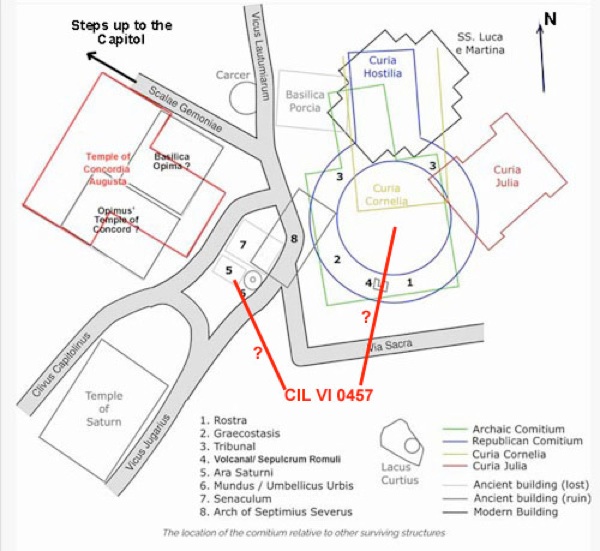
This plan, adapted from this website by René Seindal, follows F. Coarelli (referenced below, 1983 and 1985)
The Volcanal (4) is hypothesised at the site of the late Republican lapis niger (see below)
I have added an indication of the possible find spots of the inscription CIL VI 0457
Boni did not explicitly address the date of the destruction of this putative tomb in this paper, but (as we shall see), his colleagues attributed it elsewhere to the redevelopment of the area of the Comitium in ca. 80 BC. Thus while Varro might have seen them, his other two source, Dionysius and Flaccus, had not.
Varro died very shortly after the rebuilding of the Curia Julia began in 43 BC.
There are a number of possible candidates for the statue that might have stood on this column. For example, Dionysius of Halicarnassus (ca. 7 BC) recorded that, after Romulus suppressed a revolt at the Roman colony at Cameria:
“ ... he celebrated a second triumph. Out of the spoils, he dedicated a chariot and four [horses] in bronze to Vulcan and, near it, he set up his own statue with an inscription in Greek characters setting forth his deeds”, (‘Roman Antiquities’, 2: 54: 2).
It is possible that Dionysius or his source(s) imagined that this statue of Romulus stood on this column and that the nearby inscription in ‘Greek’ letters recorded his deeds: as Filippo Coarelli (referenced below, 2014, at p. 57) pointed out:
“Certainly, the letters of the cippus might ... easily have been construed [as ‘Greek’ in the light of] ... the script derived from the archaic Chalcidian alphabet brought to Italy by the Greek colonists.”
Read more:
C. Lyes, “Rethinking the Lapis Niger”, Classics Students' Journal, 1 (2017) 45-63
D. Guarisco, “Ossa Quirini: Romulus' Mortality and Apotheosis between Caesar and Augustus”’ Gremium, 10 (2016) 7-16
J. N. Hopkins, “Genesis of Roman Architecture”, (2016) New Haven and London
S. Smith, “Sacred by Design: Expressing Latin Identity through Architectural Mouldings”, (2016) thesis of Royal Holloway College, London
J. N. Hopkins, “Comitium”, (2012) Wiley On-line Library
A. D. Bartles, “Paving the Past: Late Republican Recollections in the Forum Romanum”, (2009) thesis of the University of Texas at Austin
T. De Mauro, “Ceci, Luigi”, in
H. Stammerjohann and J. Noordegraaf (editors), “Lexicon Grammaticorum: A Bio-Bibliographical Companion to the History of Linguistics’ (2009) Tübingen, at pp. 276-7
G. Forsythe, “A Critical History of Early Rome: From Prehistory to the First Punic War”, (2005) Berkeley Los Angeles and London
P. Aicher, “Rome Alive: A Source Guide to the Ancient City: Vol.1”, (2004) Mundelein, Illinois
N. Rudd (translator), “Horace: Odes and Epodes”, (2004) Cambridge MA
T. Cornell, “The Beginnings of Rome: Italy and Rome from the Bronze Age to the Punic Wars (ca. 1000-264 BC)”, (1995) London and New York
F. Coarelli, “Il Foro Romano I: Il Foro Romano I: Periodo Arcaico”, (1983) Rome
T. N. Gantz, “Lapis Niger: The Tomb of Romulus”, Parola del Passato 29 (1974) 350-61
F. Castagnoli, “Sulla Tipologia degli Altari di Lavinio”, Bullettino della Commissione Archeologica Comunale di Roma, 77 (1959-60) 145-72
E. Gjerstad, “Il Comizio Romano dell' Età Repubblicana”, Opuscula Archaeologica, 2 (1941) 97-158
S. B. Platner, “A Topographical Dictionary of Ancient Rome”, (1929) Cambridge
J. Carter, “The Death of Romulus”, American Journal of Archeology, 13:1 (1909) 19-29
F. Studniczka, “Altäre mit Grubenkammern”, Jahreshefte des osterreichischen archaologischen., 6 (1903) 123-86
G. Boni (translated into English by W. St Clair Baddeley), “The Niger Lapis in the Comitium at Rome”, Archaeologia, 57 (1900) 175-84
G. Boni, “Roma. I: Nuove Scoperte nella Città e nel Suburbio (1899)”, Notizie degli Scavi di Antichità, (1900) 151-8
G. F. Gamurrini, “Stele con Iscrizione Latina Arcaica Scoperta nel Foro Romano: Estratto dalle Notizie degli Scavi del Mese di Maggio 1899”, (1899) Rome
Return to Rome in the Early Republic (509 - 241 BC)